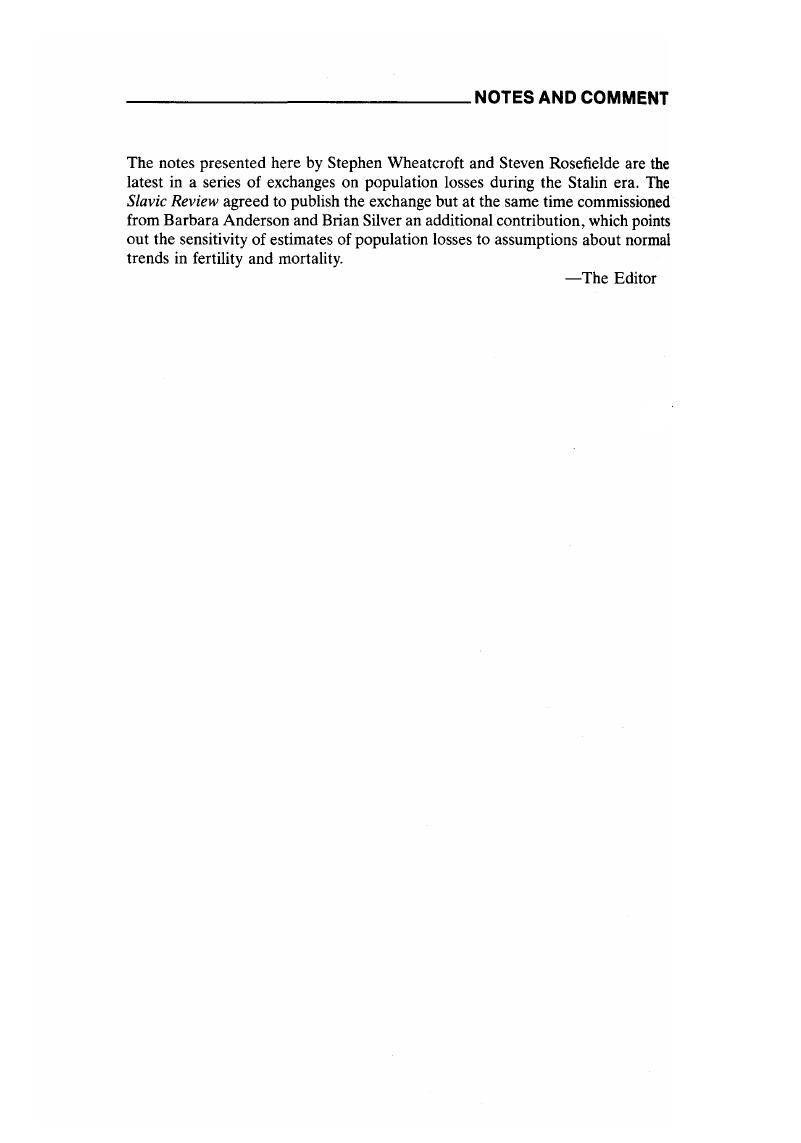Article contents
New Demographic Evidence on Excess Collectivization Deaths: Yet Another Kliukva from Steven Rosefielde?
Published online by Cambridge University Press: 27 January 2017
Abstract

- Type
- Notes and Comment
- Information
- Copyright
- Copyright © Association for Slavic, East European, and Eurasian Studies. 1985
References
1. Holland Hunter, “The Economic Costs of the GULag Archipelago “; R. W. Davies & S. G. Wheatcroft, “Steven Rosefielde's Kliukva “; Igor Birman, “Limits of Economic Measurement “; PaulGregory, “Valueless Goods and Social Bads in the Measurement of Soviet Output Series, 1928–1932,” Slavic Review, 39, no. 4 (December 1980): 588–611. S. G. Wheatcroft, “On Assessing theSize of Forced Concentration Camp Labour in the Soviet Union, 1929–56,” Soviet Studies, 33 (April 1981): 265–95; Wheatcroft, “Towards a Thorough Analysis of Soviet Forced Labour Statistics, “ibid., 35 (April 1983): 223–37, and Wheatcroft, “A Note on Steven Rosefielde's Calculation ofExcess Mortality in the USSR, 1929–1949,” ibid., 36 (April 1984): 277–81.
2. Steven Rosefielde, “Excess Mortality in the Soviet Union: A Reconsideration of the DemographicConsequences of Forced Industrialization, 1929–49,” Soviet Studies, 35 (July 1983): 385–409.
3. Wheatcroft, “A Note on Steven Rosefielde's Calculations of Excess Mortality,” pp. 277–81.
4. Sotsialisticheskoe stroitel'stvo SSSR, M.1934, p. 353, M.1935, p. 539, M.1936, p. 542. Thisfigure has not been cited in any subsequent official Soviet statistical handbook.
5. See F. Lorimer, The Population of the Soviet Union (Geneva, 1946), p. 135. In fact it is equalto it when rounded to the nearest million.
6. Rosefielde, “Excess Collectivization Deaths 1929–1933: New Demographic Evidence,” SlavicReview, 43, no. 1 (Spring 1984): 83.
7. Ibid., p.86, n. 12.
8. Urlanis, Boris, Problemy dinamiki naseleniia SSSR (Moscow, 1974), p. 324.Google Scholar
9. This is not pure surmise. I had a discussion with Urlanis about six years ago when I presentedhim with a copy of my Discussion Paper on Soviet Population Dynamic. We discussed the variousWestern estimates of Soviet population dynamic for the 1920s and 1930s that I had described in theappendix of that paper. See S. G. Wheatcroft, “Population Dynamic and Factors Affecting it in theSoviet Union in the 1920s and 1930s,” part 2, CREES Discussion Papers, SIPS no. 2, BirminghamUniversity, 1976, pp. 64–75, where the estimates of Lorimer, Prokopovich, Kulisher, Martshenko,and Biraben are described and analyzed). When asked how his estimation of the dynamic woulddiffer from these, he emphasized the general uncertainty of the figures and took the view that theProkopovich, Kulisher, Martshenko, and Biraben figures exaggerated the scale of demographic crisis,while Lorimer's estimate was “as good as any.“
10. To be fair to Rosefielde, Urlanis's table is a little misleading because it failed to place adate in front of the 1933 figure, but it clearly refers to April 1 as the plan documents indicate. SeePiatiletnii plan razvitiia SSR, torn 1, M.1929, p. 129. Incidentally, Urlanis's table is also incorrectsince the figure for the Gosplan base year, -151.3, refers not to April 1, 1927 but to April 1, 1928.See ibid., p. 319.
11. Ibid., p. 318.
12. In 1931 the official figure for the urban population was based on urban registration dataand on ration and other data, but the total figure for urban and rural population combined was basedon a population projection, as can readily be ascertained by checking the age by sex structure forthe total 1931 population given in Narodnoe khoziaistvo SSSR (Moscow, 1932), p. 404.
13. V. P. Danilov, “Dinamika naseleniia SSSR za 1917–1929 gg., (Opyt arkheograficheskikh iistochnovedcheskogo otbora dannykh dlia rekonstruktsii demograficheskogo protsessa),” Arkheograficheskiiezhegodnik, 1968 (Moscow, 1970), pp. 242–53.
14. Rosefielde, “Excess Collectivization Deaths,” p. 83. For the earlier citations of the sourcesfor this figure see n. 4 above.
15. The Prokopovich and Martshenko estimations were reviewed by me in SIPS no. 2, 1974(see n. 9 above). I am currently revising this paper to include the growing number of subsequenterroneous evaluations, e.g. Maksudov, Antonov-Ovseenko, Diadkin, and Rosefielde.
16. “Some 5 million persons died during the liquidation of kulaks and forced land collectivizationin the early 1930s. The next famine of 1932–34 claimed another 5 million or more lives. “Murray Feshbach, “The Soviet Union: Population Trends and Dilemmas,” Population Bulletin, 37,no. 3 (August 1982): 7. For the entire inter-census period 1926–1939, Feshbach apparently believesthat there were 15–20 million excess death.
17. At the beginning of the section in which these estimates are made, Feshbach states in afootnote, “This section is based on Frank Lorimer, The Population of the Soviet Union, Geneva 1946;B. Ts. Urlanis, ‘Liudskiye poteri vooruzhennykh sil v Evropeiskikh voinakh’ in B. Ts. Urlanis,Narodonaselenie: issledovaniiapublitsistika, Moscow 1976, pp. 177–213; and Stephen G. Wheatcroft, “The Population Dynamic and Factors Affecting it in the Soviet Union in the 1920s and 1930s, “University of Birmingham, Soviet Industrialisation Project Series, nos. 1 and 2, 1976.” While I donot wish to quarrel with Feshbach, for whom I have the greatest respect, I must nevertheless pointout that there is nothing in any of the above cited works that supports these massive claims.
18. James E. Mace, “Famine and Nationalism in Soviet Ukraine,” Problems of Communism, 33 (May-June 1984): 37–50.
19. Cohen, Stephen F., “The Stalin Question since Stalin” in Cohen, Stephen, ed., An End toSilence: Uncensored Opinion in the Soviet Union (New York, 1982), p. 23 Google Scholar, and “The Stalin Question “in James Cracraft, ed., The Soviet Union Today (Chicago, 1983), pp. 21 and 32.
20. Apart from my works listed in n. 9, see Leo Van Rossum, “A. Antonov-Ovseenko's bookon Stalin: Is it Reliable?” Soviet Studies, 36 (July 1984): 445–47, and Michael Paul Sacks, review ofUnnatural Deaths in the USSR, 1928–1954 by Iosif G. Dyadkin, Slavic Review, 43, no. 1 (Spring1984): 119–20. We all await the publication of the third volume of R. A. Lewis's work on Sovietpopulation, which promises to cover the question of population losses, and which should add someneeded weighty scholarly opinion to this topic.
- 4
- Cited by




